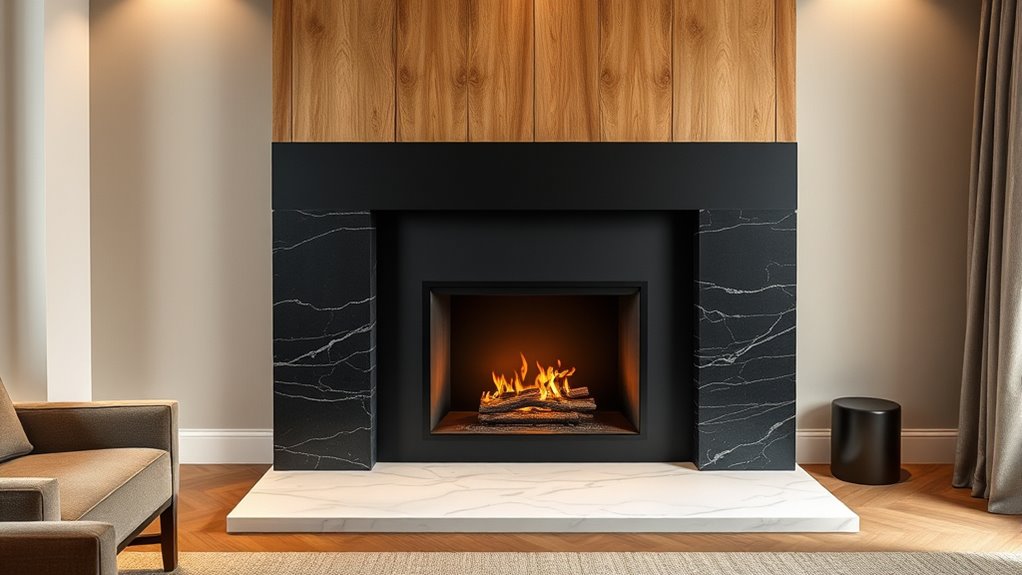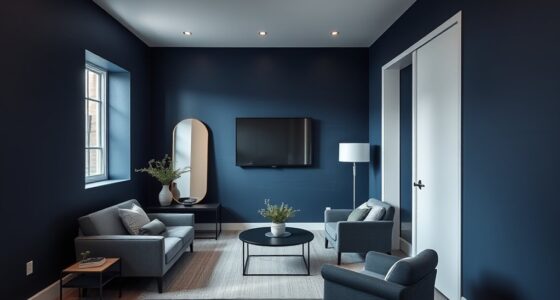When choosing materials for your fireplace feature wall, consider options like natural stone, brick, or tile for durability and style. Make sure to follow safety regulations by maintaining proper clearances and using fire-resistant barriers or coatings, especially with combustible materials like wood. Proper installation, ventilation, and regular maintenance are key to safety and longevity. Keep in mind that understanding heat management helps prevent fire hazards—continue exploring for detailed tips and best practices.
Key Takeaways
- Choose heat-resistant and fire-resistant materials like stone, brick, or tile for durability and safety.
- Ensure proper clearance distances between combustibles and the fireplace according to local building codes.
- Use fire-resistant coatings or barriers to enhance safety on combustible surfaces near the fireplace.
- Follow manufacturer guidelines for installation, including leveling and spacing, to prevent heat damage and ensure safety.
- Regularly inspect and clean the feature wall to maintain safety, prevent soot buildup, and prolong material lifespan.
Popular Materials for Fireplace Feature Walls
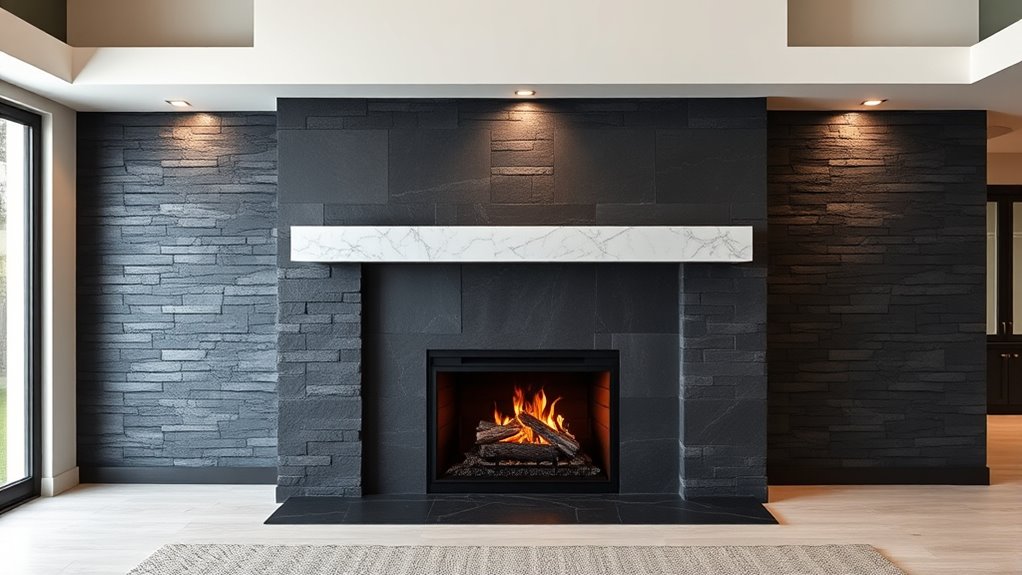
When choosing a material for your fireplace feature wall, it’s important to contemplate both style and durability. Your fireplace design plays a key role in setting the room’s overall aesthetic appeal, so selecting the right material is essential. Options like natural stone, brick, or tile offer timeless charm and texture, enhancing visual interest. Fireplaces with stone or brick exude a rustic, cozy vibe, while sleek tiles provide a modern, polished look. Consider how each material complements your existing decor and personal style. Durability is also indispensable; choose materials that withstand heat and daily wear. By combining your aesthetic preferences with practical considerations, you’ll create a feature wall that not only appeals visually but also endures over time. For a cohesive design, think about how the fireplace feature wall integrates with other elements of your farmhouse bedroom. Additionally, exploring fireplace materials can help you select options that balance style and resilience effectively. Incorporating heat-resistant materials ensures your feature wall remains beautiful and functional for years to come.
Choosing the Right Material for Your Space
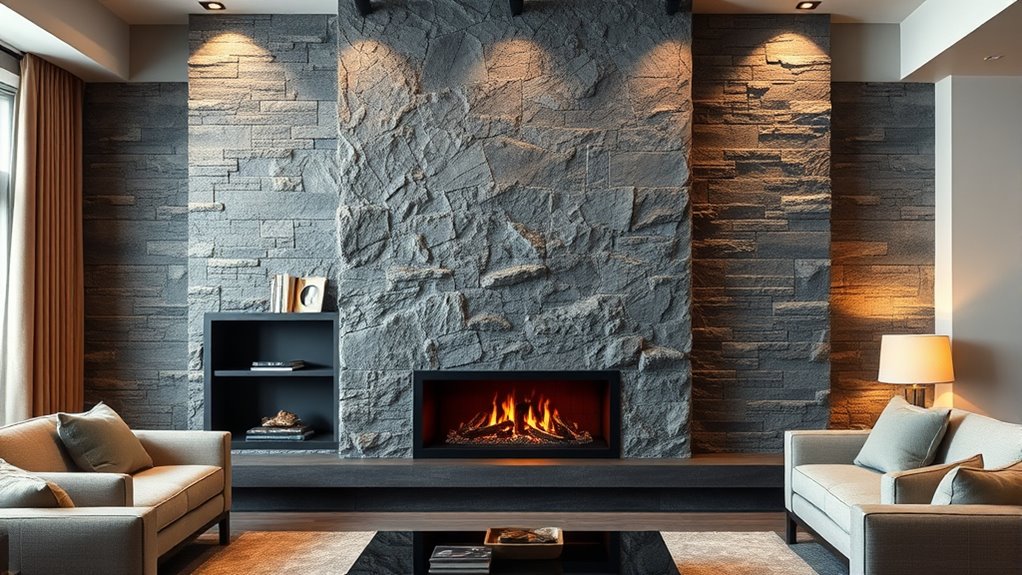
Selecting the right material for your fireplace feature wall depends on your space’s size, lighting, and existing decor. If your room is small or has limited natural light, opt for lighter materials like marble or neutral tiles to create an open, airy feel. For larger spaces, bold materials such as dark stone or textured brick can add drama and depth to your fireplace design. Consider how the material complements your interior decor—sleek metal or glass works well in modern settings, while wood or stone suits rustic or traditional styles. Think about maintenance and durability as well. The goal is to choose a material that enhances your overall aesthetic and creates a cohesive look, making your fireplace a standout feature in your home.
Safety Considerations and Fire-Resistant Options
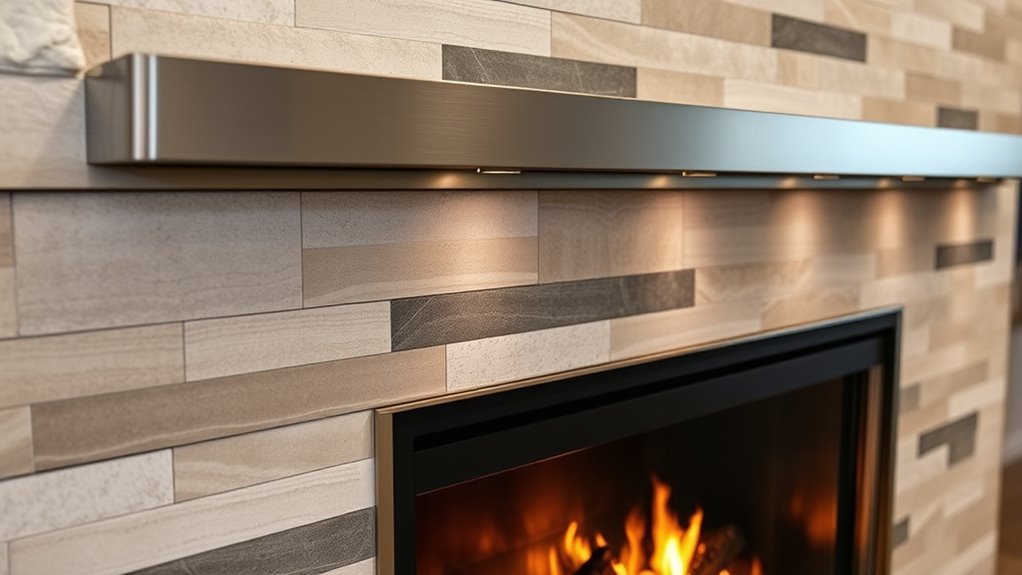
Choosing the right materials for your fireplace feature wall not only affects its appearance but also impacts safety. To prevent fire hazards, consider using fire resistant coatings on combustible surfaces to add an extra layer of protection. These coatings help contain heat and reduce the risk of ignition from sparks or high temperatures. Additionally, installing combustible wall protection, such as fire-resistant drywall or panels, creates a barrier that minimizes fire spread. Always ensure your materials meet local safety codes and standards for fire resistance. Using fire-resistant options and protective coatings helps safeguard your home and loved ones, providing peace of mind. Remember, safety should never be compromised when designing your fireplace feature wall. Incorporating fireplace accessories that are designed with safety in mind can further enhance protection and functionality.
Proper Clearances for Different Materials
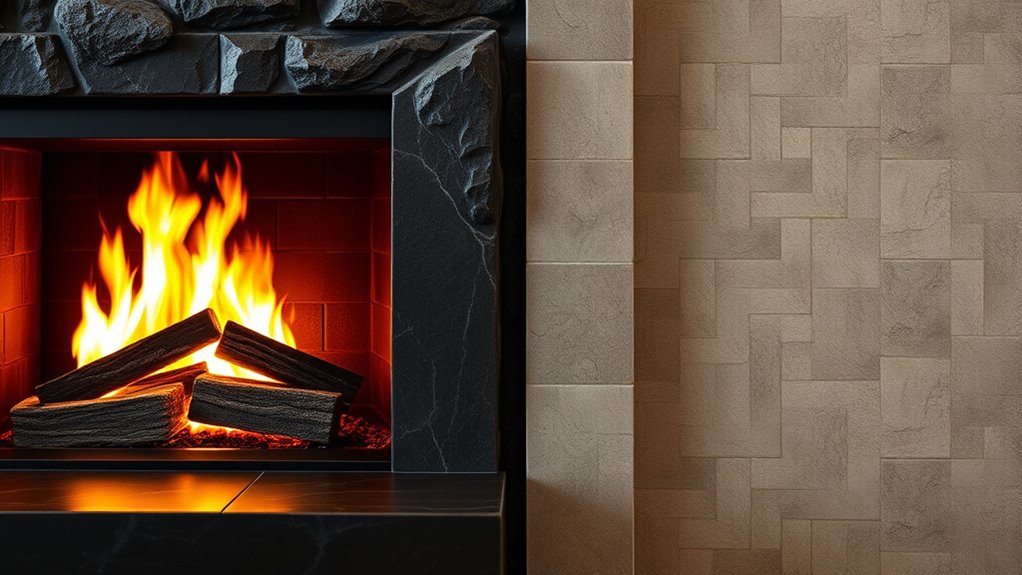
Proper clearances are essential to guarantee safety and compliance when installing your fireplace feature wall, especially since different materials require specific spacing from heat sources. For combustible materials, maintain adequate clearance to prevent heat buildup and potential fires. Understanding heat transfer principles can help you select appropriate materials and clearances, ensuring efficient heat dissipation and safety. Additionally, thermal conductivity of materials influences how heat is transferred and how much clearance is needed to prevent overheating. Non-combustible surfaces, like certain heat shielding panels, can be placed closer to the fireplace, but always follow manufacturer guidelines. Fireplace venting systems also demand proper clearances to ensure safe operation and proper heat dissipation. Remember, inadequate spacing can cause overheating, damage, or fire hazards. Heat transfer properties of materials play a crucial role in determining the appropriate clearances for different surfaces. Consult local building codes and manufacturer instructions to determine exact measurements for each material. Proper clearances not only protect your home but also maximize the efficiency and longevity of your fireplace feature wall.
Installing Stone and Brick Fireplace Walls

Installing stone and brick fireplace walls requires careful preparation to guarantee durability and safety. Begin by selecting materials that complement your fireplace design and desired aesthetic enhancements. Confirm the wall surface is level, clean, and structurally sound before laying bricks or stones. Use high-quality mortar suited for masonry work, applying it evenly to prevent gaps or shifting over time. Pay attention to proper spacing and alignment, creating a cohesive look that enhances your fireplace’s visual appeal. Incorporate a suitable fire-resistant backing or reinforcement if needed, especially for larger or more elaborate designs. Proper installation not only elevates the aesthetic but also ensures the wall withstands heat exposure and daily use, making your fireplace a safe and attractive feature in your space. Additionally, understanding fire safety regulations can help ensure your installation meets all necessary standards for safe operation. Being aware of masonry techniques can further improve the quality and longevity of your fireplace wall. Proper material selection plays a crucial role in ensuring the wall’s overall performance and safety over time. To optimize the longevity of your fireplace wall, consider using appropriate sealants to protect against moisture and environmental damage.
Tiling Options and Installation Tips

When choosing tiling materials for your fireplace wall, consider durability, heat resistance, and style to match your space. Proper installation techniques, like leveling and grouting, are essential for a smooth, professional finish. Keep these best practices in mind to guarantee your tiled feature wall looks great and lasts for years.
Tiling Materials Selection
Are you unsure which tiling materials will best enhance your fireplace feature wall? Choosing the right materials can elevate your space with decorative accents and lighting enhancements. Consider options like natural stone for a timeless look or sleek ceramic tiles for modern elegance. Glass tiles can add reflective qualities that brighten the area, while textured options bring depth and visual interest. When selecting materials, think about durability and heat resistance to guarantee safety and longevity. Additionally, understanding heat resistance of the materials ensures your fireplace wall remains safe and durable over time. Consulting with professionals can also help you select the best tiling options suited for high-temperature environments to prevent damage. Considering cost and budgeting factors can help you balance quality and affordability when choosing your tiles. Color and finish also matter—glossy surfaces reflect light beautifully, emphasizing lighting features, while matte finishes provide a subdued backdrop. By carefully matching your chosen tiles with your overall decor, you can create a stunning focal point that combines style and practicality effortlessly. Exploring personal development principles like goal setting and visualization can further assist you in planning your renovation project effectively.
Installation Best Practices
Choosing the right tiling options sets the foundation for a beautiful fireplace feature wall, and proper installation guarantees your design looks polished and lasts over time. Start by making certain the surface is clean, dry, and free of dust or grease to prevent issues during tiling. Use quality adhesive and follow manufacturer instructions for proper application. During installation, consider chimney troubleshooting; if the chimney isn’t venting properly, it can cause moisture buildup that affects your tiles. Regular fireplace cleaning also helps maintain the integrity of your wall, preventing soot and grime from damaging the tiles. Take your time measuring and leveling tiles to avoid uneven surfaces. Proper spacing and grout sealing are essential for durability and a professional look. Additionally, understanding fireplace safety clearances is crucial to prevent heat damage and ensure compliance with building codes. These best practices ensure your fireplace feature wall remains stunning and functional. Remember that adhering to installation best practices can help prevent potential hazards and extend the lifespan of your fireplace. Ensuring proper clearance requirements between the firebox and combustible materials is vital for safety and code compliance. Regularly inspecting your fireplace’s ventilation system can also prevent moisture issues that may compromise your tiling.
Wood and Other Combustible Materials: What to Know

Wood and other combustible materials require careful consideration when designing a fireplace feature wall, as they can pose fire hazards if not properly managed. When planning your fireplace design, choose materials that are fire-resistant or have appropriate protective barriers to prevent heat transfer. Using natural wood or combustible accents can add warmth and texture, enhancing the aesthetic appeal of your space. However, make certain these materials are installed with proper clearances and in compliance with safety standards. Incorporating fire safety standards is essential to ensure your design adheres to all necessary regulations. Using proper clearances and fire-resistant materials can significantly reduce the risk of fire hazards and promote a safer environment. Additionally, understanding fire-resistant materials can help you select the best options for both safety and style.
Ventilation and Clearance Regulations

Proper ventilation and clearances are vital for guaranteeing your fireplace feature wall remains safe and functional. Adequate chimney venting is essential to prevent dangerous buildup of smoke and gases, maintaining safe indoor air quality. Make sure your chimney venting system is properly installed and inspected regularly to meet local codes. Good air circulation helps disperse heat and prevents overheating of combustible materials near the wall. Clearances between the fireplace and combustible surfaces must be maintained according to manufacturer and code guidelines to reduce fire risks. Always adhere to the recommended distance requirements and avoid obstructing vents or airflow pathways. Proper ventilation and clearance regulations not only protect your home but also ensure the efficient operation of your fireplace feature wall. Regular maintenance and adherence to safety standards are crucial for preventing hazards associated with inadequate exhaust management.
Maintaining and Caring for Your Fireplace Wall
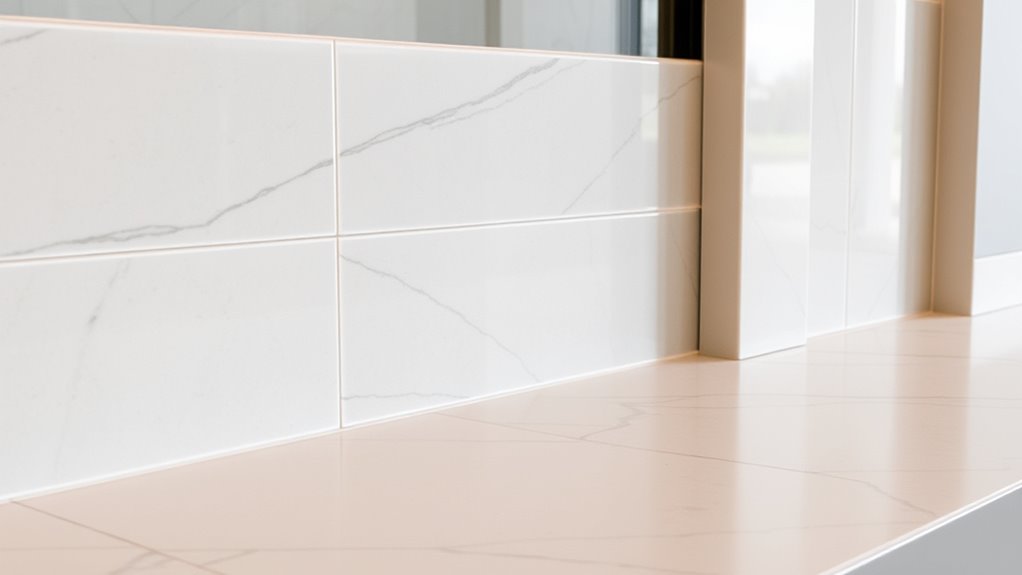
Regular maintenance is key to keeping your fireplace wall safe and attractive. Proper fireplace maintenance involves routine inspections and cleaning to prevent soot buildup, cracks, and other damage. To keep your wall looking its best, follow simple cleaning tips such as using a soft brush or vacuum to remove dust and debris. For tile or stone surfaces, gentle cleaners specifically designed for those materials work well. If you notice discoloration or soot stains, clean them promptly to prevent staining. Remember, always allow the fireplace to cool completely before cleaning. Regular upkeep not only preserves the aesthetic appeal but also guarantees safety and efficiency. By staying consistent with your fireplace maintenance, your feature wall remains a stunning and functional focal point in your home.
Frequently Asked Questions
Can I Install a Fireplace Feature Wall Myself?
You can attempt a DIY installation of a fireplace feature wall, but it’s essential to follow safety precautions. Make sure you understand the materials needed and local building codes. If you’re comfortable with tools and have some experience, you might handle the project yourself. However, for safety and proper clearance adherence, consulting a professional is wise. Proper installation ensures safety, efficiency, and a stunning focal point in your space.
How Does Climate Affect Material Choice for Fireplace Walls?
Climate considerations greatly influence your material choice for fireplace walls. If you live in a humid or coastal area, opt for materials with high durability and resistance to moisture, like brick or stone. In colder regions, materials that withstand temperature fluctuations, such as tile or concrete, are ideal. Choosing the right materials guarantees your fireplace wall remains safe, functional, and visually appealing, regardless of climate challenges.
Are There Eco-Friendly Options for Fireplace Feature Walls?
Yes, you can choose eco-friendly options for your fireplace feature wall. Look for sustainable options like reclaimed wood, recycled metal, or glass made from recycled bottles. These materials reduce environmental impact and add unique character to your space. By selecting recycled materials, you support sustainability and create a stylish, eco-conscious focal point in your home. Always verify that the materials meet safety clearances and fire codes before installation.
What Are the Costs Associated With Different Fireplace Wall Materials?
You might think all fireplace wall materials cost the same, but a cost comparison shows significant differences. Materials like tile and stone offer great durability, but they can be pricier upfront. Fire-resistant drywall is more budget-friendly but less durable long-term. You’ll want to weigh the initial costs against durability, since choosing a high-quality material might save you money on repairs or replacements down the line.
How Often Should I Inspect My Fireplace Wall for Safety?
You should inspect your fireplace wall at least once a year to guarantee fire safety. Regular inspections help identify signs of damage, creosote buildup, or cracks that could pose safety risks. During your maintenance schedule, look for any discoloration, loose tiles, or unusual odors. If you notice any issues, address them promptly to prevent hazards. Consistent inspections keep your fireplace safe and functioning efficiently, giving you peace of mind.
Conclusion
Think of your fireplace feature wall as the heart of your home’s gathering space—a glowing beacon that welcomes everyone in. Choosing the right materials and clearances guarantees it stands strong and safe, like a sturdy lighthouse guiding ships safely ashore. With proper care and attention, your fireplace wall will shine brightly for years to come, creating warm memories and a cozy atmosphere. Make it a centerpiece that’s both beautiful and built to last.
